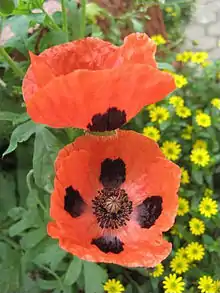Papaver commutatum
Papaver commutatum, the Caucasian scarlet poppy,[1] is a species of flowering plant in the family Papaveraceae native to northern Turkey, northwestern Iran and the Caucasus. It is an erect annual growing to 45 cm (18 in) tall by 15 cm (6 in) wide, with hairy stalks and leaves. The flower is bowl-shaped and about 8 cm (3 in) in diameter, bright red with prominent black blotches at the bases of the petals, and is borne in early summer. The flowers are followed by spherical seed heads.[2]
| Papaver commutatum | |
|---|---|
 | |
| Scientific classification | |
| Kingdom: | Plantae |
| Clade: | Tracheophytes |
| Clade: | Angiosperms |
| Clade: | Eudicots |
| Order: | Ranunculales |
| Family: | Papaveraceae |
| Genus: | Papaver |
| Species: | P. commutatum |
| Binomial name | |
| Papaver commutatum | |
The Latin specific epithet commutatum means “changed”, referring to a change of name from another species.[3]
The cultivar P. commutatum 'Ladybird' is a popular and easy garden annual for a sunny position in a moist, fertile spot. It bears many flowers on each plant and blooms from late spring to early summer. It is frequently a feature of cultivated wildflower meadows.[4] It has gained the Royal Horticultural Society's Award of Garden Merit,[5][6] as has the species. [7]
References
- "Papaver commutatum". RHS. Retrieved 18 February 2019.
- RHS A-Z Encyclopedia of Garden Plants. United Kingdom: Dorling Kindersley. 2008. p. 1136. ISBN 1405332964.
- Harrison, Lorraine (2012). RHS Latin for Gardeners. United Kingdom: Mitchell Beazley. ISBN 184533731X.
- "Papaver commutatum 'Ladybird'". Gardenia.net. Retrieved 18 February 2019.
- "RHS Plant Selector - Papaver commutatum 'Ladybird'". Retrieved 16 January 2021.
- "AGM Plants - Ornamental" (PDF). Royal Horticultural Society. July 2017. p. 71. Retrieved 17 April 2018.
- "Papaver commutatum". www.rhs.org. Royal Horticultural Society. Retrieved 24 January 2021.
- Sariyar, G. (2002). Biodiversity in the alkaloids of Turkish Papaver species. Pure and Applied Chemistry 74(4), 557-74.